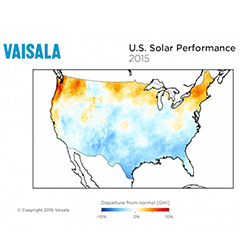Vaisala annual performance study illustrates effects of anomalous weather on Texas and other emerging U.S. solar markets
Vaisala, a global leader in environmental and industrial measurement, has today released solar performance analysis revealing that solar irradiance levels were 5% below long-term averages across the southern U.S. in 2015. The corresponding impact on project performance was felt most notably during the first two quarters, when operators in emerging solar markets, including Texas, saw irradiance levels more than 10% below normal.
While the majority of operational solar capacity in the U.S. is concentrated on the East and West Coasts, the industry has identified the southern U.S., notably Texas, as a region with considerable solar development potential. Over 300 MW of new solar projects were scheduled to come online in Texas in 2015, and a construction boom is anticipated in the coming years as the solar sector looks to emulate the success of wind energy in the region.
In this context, evidence of potential project underperformance may pose an unwelcome obstacle to future growth. 2015 was a wetter than normal year across much of the United States, which was beneficial for states struggling with drought, but not necessarily for the solar industry. Texas and the surrounding area, for example, were hit particularly hard in three of the last four quarters by significantly cloudier conditions than average.
Numerous operational solar sites in the region would have recorded poor performance levels during these months, especially given that many operators and asset managers still do not account for the production impact of weather deviations from long-term conditions when monitoring performance. The situation creates a difficult starting point for an industry trying to get off the ground in a new region.
Vaisala’s 2015 Solar Performance Maps and analysis illustrate the influence of short-term, quarter-by-quarter weather variations on output at U.S. solar projects and places them into a long-term context. This reveals frequent and significant departures from long-term average irradiance conditions and highlights the clear requirement to analyze the effect of solar resource variability on both over and underperformance.
“There was more storm activity than usual this past year,” said Gwendalyn Bender, Solar Energy Product Manager at Vaisala. “Disturbances in the normal upper-level flow patterns in the first half of the year and the onset of a strong El Niño in the second half created particularly wet conditions in the central and western United States.”
“However, the Northeast was spared the impact of last year’s storms with higher than average irradiance most of the year, especially during summer peak load, and the Northwest experienced exceptionally high irradiance conditions.”
Weather patterns like El Niño have a direct impact on power production at solar plants. Vaisala’s solar performance maps highlight why it is particularly critical to weather-adjust power performance at operating facilities using on-site measurements or a regular weather data feed.
Accounting for weather is the vital first step in assessing whether a solar plant is performing as expected. This is particularly important for plants coming online without a benchmark of long-term irradiance variability. In these cases, knowing when solar conditions were well above or below normal avoids a great deal of wasted time and operational budget trying to correct potential equipment problems that simply do not exist.
Furthermore, on a broader scale, irradiance fluctuations illustrate the importance of building a climate resilient portfolio. This involves paying close attention to how weather patterns can vary in different geographies and constructing a diverse portfolio of projects that balances and mitigates their effects on power production. In practice, this might mean building projects in different regions or building some solar and some wind projects in the same region.
Vaisala is an expert in solar measurement, project assessment, and energy forecasting. It acquired 3TIER in 2013, a company that developed the first high-resolution, global solar dataset and has helped secure over US$10 billion in project financing worldwide. For more information on the range of services offered by Vaisala to the renewable energy sector, please visit www.vaisala.com/energy
For more details, meet with our experts at the Solar Asset Management: North America conference in San Francisco, March 16-17, or download Vaisala’s 2015 U.S. Solar Performance Maps, which include a report of key findings from the twelve-month climate analysis.
Vaisala Energy
Weather is the largest variable impacting electricity generation, transmission, and demand and it provides the fuel for renewable energy projects. Energy customers work with Vaisala to support efficient, reliable, and profitable electrical energy systems around the globe with a wide range of measurement, assessment, forecasting, and asset management products and services. Our real-time and historical lightning information ensures continuous energy generation, improved safety, and reduced costs in both energy production and transmission. Renewable energy developers and operators use Vaisala equipment and services to support the entire project lifecyle, from greenfield prospecting and due diligence to operational forecasting and plant optimization. linkedin.com/company/vaisala-energy twitter.com/VaisalaEnergy
About Vaisala
Vaisala is a global leader in environmental and industrial measurement. Building on 80 years of experience, Vaisala contributes to a better quality of life by providing a comprehensive range of innovative observation and measurement products and services for chosen weather-related and industrial markets. Headquartered in Finland, Vaisala employs approximately 1600 professionals worldwide and is listed on the NASDAQ OMX Helsinki stock exchange. www.vaisala.com www.twitter.com/VaisalaGroup


























